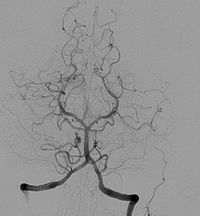
Photo from wikipedia
Objective: Aortic pulse wave velocity (PWV) is a validated indicator of central arterial stiffness and cardiovascular risk. We aimed to compare the repeatability of PWV measures obtained with non-invasive devices.… Click to show full abstract
Objective: Aortic pulse wave velocity (PWV) is a validated indicator of central arterial stiffness and cardiovascular risk. We aimed to compare the repeatability of PWV measures obtained with non-invasive devices. Design and method: We evaluated the repeatibility of non-invasive measures of PWV, obtained with 4 devices measuring two-points carotid-femoral PWV (Complior, PulsePen ETT, PulsePen ET, SphygmoCor), and with 2 devices estimating PWV from the oscillometric cuff-derived brachial pulsewave (BPLab, Mobil-O-Graph). 102 patients planned to undertake a cardiac catheterization (age 65 ± 13 years, 70.6% males) were enrolled. Repeated measures of PWV were obtained with all devices in a single session, 15 minutes apart. Duplicate PWV and carotid-femoral PTT measurements were compared using different indices. Coefficients of variation (CV%) and their confidence intervals (CI) are reported. Results: Devices evaluating carotid-femoral PWV showed a good repeatability (CV%[CI] for Complior: 8.8[7.3–10.1]; PulsePen ETT: 8.0[6.2–9.5]; PulsePen ET: 5.8[4.9–6.6]; SphygmoCor: 9.5[7.7–11.0]), whereas the repeatability of PWV estimated by cuff-based devices was slightly higher (BPLab: 5.5[4.2–6.6], Mobil-O-Graph: 3.4[2.9–3.8]). A lower repeatability of carotid-femoral PWV was present for greater arterial stiffness values (CV%[CI] for PWV<10 m/s vs PWV>=10 m/s: Complior 7.0[5.4–8.3] vs 10.5[8.0–12.5], PulsePen ETT 6.3[3.6–8.1] vs 9.2[6.5–11.3], PulsePen ET 4.9[3.5–6.0] vs 6.5[5.3–7.6], Sphygmocor 8.5[5.7–10.6] vs 10.3[7.7–12.3]. No such difference was observed with cuff-based devices (BPLab 6.0[3.6–7.7] vs 5.1[3.5–6.4], Mobil-O-Graph 3.5[2.8–4.1] vs 3.2[2.6–3.7]). Differences between repeated PWV measurements were not correlated with concomitant blood pressure (R2: 0.005) or heart rate differences (R2: 0.013). Conclusions: Short-term repeatability of PWV measures was good but not homogenous among different devices. A greater repeatability was observed with cuff-based devices, compared to devices measuring carotid-femoral PWV. This is probably due for Mobil-O-Graph to the algorithm for PWV assessment, which considers age and mean blood pressure, and for BPLab to the automated editing procedure which eliminates highly variable PWV values. Repeatability of PWV is not influenced by blood pressure or heart rate concomitant changes. For carotid-femoral PWV, the repeatability of measures is lower for higher PWV values. These results could be usefully considered when assessing PWV in a clinical setting.
Journal Title: Journal of Hypertension
Year Published: 2017
Link to full text (if available)
Share on Social Media: Sign Up to like & get
recommendations!